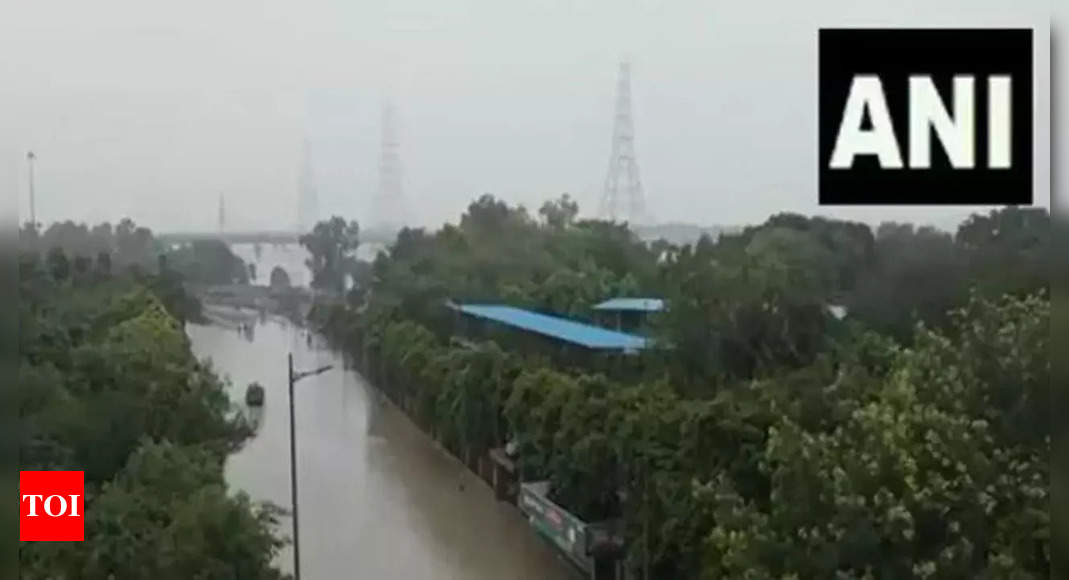NEW DELHI: Delhi was in uncharted waters as Yamuna continues to flow at 208.62 metres, above the danger mark. However, no changes were recorded in the water levels of the river in the past two hours, an official statement said on Thursday. Here are the key developments:


03:22
Delhi floods: Waterlogged homes, traffic mess, flooded streets-capital’s worst nightmare
- A senior Central Water Commission official said on Thursday the water level of the Yamuna river in Delhi has stabilised and will start receding tonight. According to the CWC flood-monitoring portal, the water level at the Old Railway Bridge rose to 208.62 metres at 1 pm and remained stable till 4 pm. “The water level has stabilised and it will start coming down in the next four hours. It is expected to drop to 208.45 metres by 3 am on Friday,” CWC director Sharad Chandra said.
- Traffic crawled on several stretches and commuters struggled to reach their destinations as water from the Yamuna spilled onto the roads of the national capital, prompting the Delhi Traffic Police on Thursday to issue an advisory on vehicular movement. There is no restriction on vehicles carrying essential services such as food items and petroleum products, the police said. The closure of roads due to the Yamuna overflowing also hit traffic in several parts of the city, especially east Delhi, where commuters were stuck for hours.
- The raging river has inundated several areas, impacted public and private infrastructure, road and rail traffic and caused immense hardships to people living near the river.
- Looking at the grim situation, the Delhi government on Thursday announced that all Delhi schools and colleges will remain closed till Sunday and government offices, except those providing essential services, will resort to work from home.
- CM Kejriwal said that the entry of heavy vehicles, except those providing essential services have been banned during this period.
- The Delhi Disaster Management Authority on Thursday directed that all non-essential government offices, schools and colleges in the city be closed till Sunday. Private establishments across the city have been advised to work from home.
- The Municipal Corporation of Delhi said that there is a possibility of water entering the Nigam Bodh Ghat, which could hamper cremation activities, adding that people are advised not to venture to the open-air cremation ground and use some other ground instead.
- Meanwhile the India Meteorological Department (IMD) on Thursday predicted that South-West Delhi and adjoining areas is likely to receive light to moderate intensity rain on Thursday.
- Reguesting Delhiites, residing in flood affected areas, to not leave their houses if not essential, Kejriwal said the Yamuna River’s water level will reach its peak by 3-4 pm Thursday and then it will start receeding.
- He said that about 25 per cent water supply in the national capital has been affected due to the flood situation but assured that the water supply in these areas will restart by Friday.
- Chief minister Arvind Kejriwal has urged the Centre to intervene and the city police imposed Section 144 of the CrPC in flood-prone areas to prevent unlawful assembly of four or more people and public movement in groups.
- The Delhi high court has directed the city’s civic authorities to inspect the Sriniwaspuri area and suggest remedial measures after a resident filed a plea claiming that water and sewage entered her house following heavy rains over the weekend.
- As flood water entered the Sushruta Trauma Centre at 9 Metcalf Road, patients are being safely shifted to safer places in Delhi.
- Amid heavy rain and flash floods, Northern Railway has suspended train services as a precautionary measure due to the flood-like situation.
- Major floods in Delhi occurred in 1924, 1977, 1978, 1988, 1995, 1998, 2010 and 2013. An analysis of flood data from 1963 to 2010 indicates an increasing trend for floods occurring in September, and a decreasing trend in July, according to research.
With agency inputs
